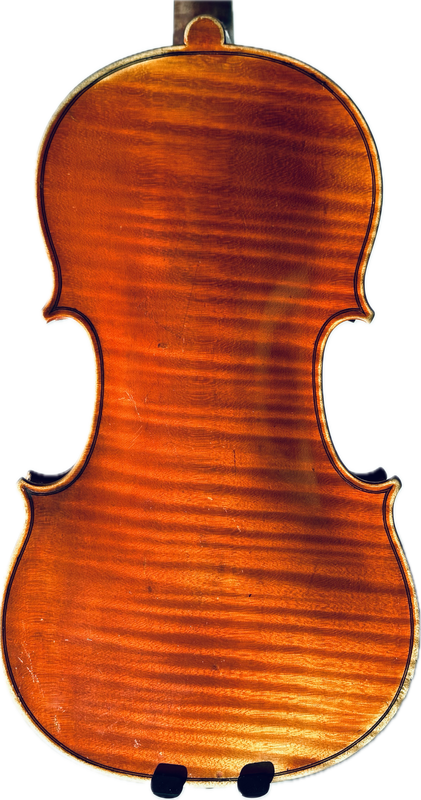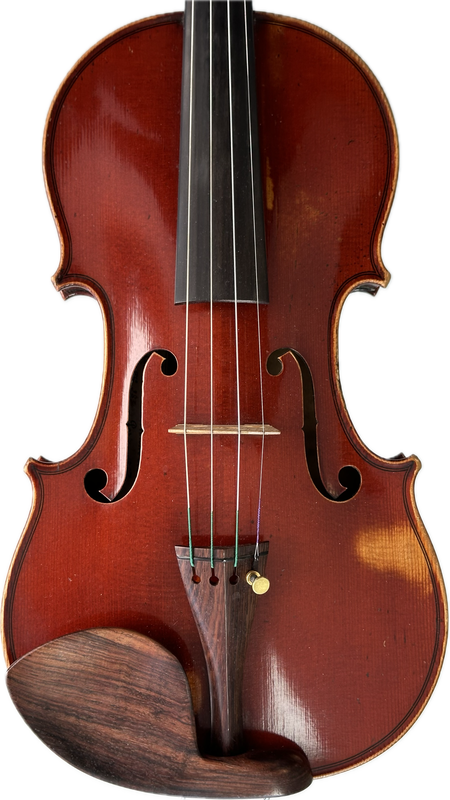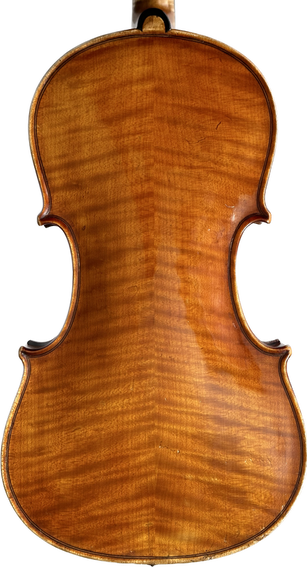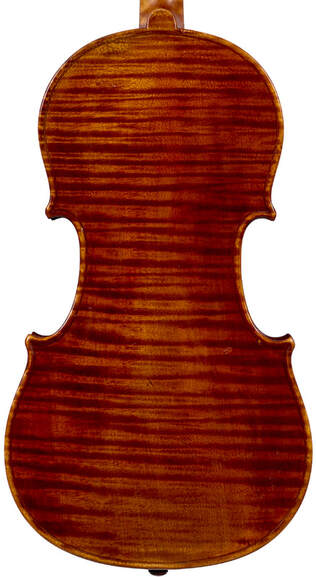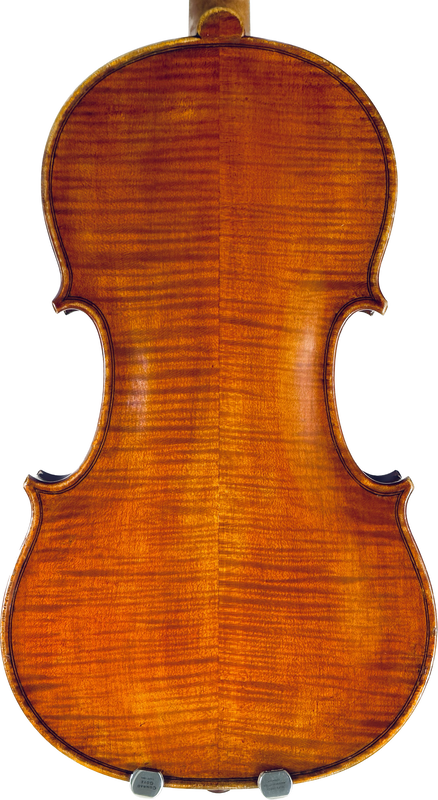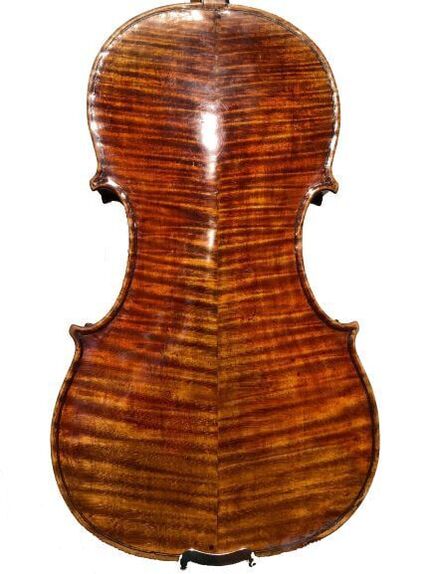Fine & Professional Level Violins
$50,000 - $200,000
Choose a price range: Up to $10,000 $10,000 - $20,000 $20,000 - $50,000
$50,000 - $200,000 Fine & Rare Instruments
$50,000 - $200,000 Fine & Rare Instruments
We carry a selection of fine antique and contemporary Italian, French, English, German and American instruments
|
Hippolyte Chrétien Silvestre, Lyon 1879
Featured Instrument Fine French Violin by Hippolyte Chrétien Silvestre, Lyon 1879. H.C. Silvestre (b.1845, d.1913) was the nephew of both Pierre and Hippolyte Silvestre. He was trained by them and eventually took over their shop in 1865. Pierre Silvestre had, in turn, worked for the two greatest masters of the French school, Lupot and Vuillaume. H.C. partnered with Maucotel in 1900. His instruments typically feature beautifully figured maple, wide-grain spruce and a glowing and supple red varnish. This instrument has a shining, powerful tone. More pictures coming soon... Available Now |
|
Gand & Bernardel 'ex-Daniel Guilet', Paris 1867
Featured Instrument Charles Nicolas Eugène Gand and brothers Gustave and Ernst Bernardel were direct descendants of the Lupot legacy. Their fathers, Charles Francois Gand (Gand père) and Augusts Sébastien Philippe Bernardel (Bernardel père) were both employed by Nicolas Lupot. Gand père married Lupot's adopted daughter in 1811 and inherited Lupot's shop and title upon his death in 1824. Bernardel père stayed on with Maison Gand until 1826, presumably to finish important orders which Lupot was unable to complete before his passing. That year, Bernardel père opened his own shop almost directly across the street from Maison Gand. Brothers, Charles Adolphe and Charles Nicolas Eugène Gand took over the Gand shop in 1845 however, the death of Charles Adolphe left the younger brother in the difficult position of running the shop by himself. He and the Bernardel frères formed a mutually beneficial partnership in which they jointly shared the imperial titles bestowed on Maison Gand in addition to joining their client list, materials and the division of labor. In 1866, Charles Eugène Gand closed his doors and moved into the Bernardel premisis and the partnership was formed. They ran one of the most important violin businesses of any era and their own production benefits from the enormous number of fine Italian instruments they dealt with while still adhering hearing to the tradition which Lupot had established. Nicolas Lupot is considered the founder of the French violinmaking tradition and is regarded as the greatest of the French makers. We are fortunate to have one of the very finest violins by Lupot and this wonderful example by the Gand and Bernardel firm available at this time. This example, dated 1867, was owned by Daniel Guilet of the famed Beaux Art Trio. This instrument is tonally spectacular and it is uncommonly bright and direct. Its tone is beautifully mature and it embodies many of the best aspects of the late 19th century French school. It is to be sold with a certificate from Reuning & Son as well as a letter from Guilet's family. Available Now |
|
Antonio Sgarbi, Rome 1900
Featured Instrument Antonio Sgarbi (b.1866, d.1905) was born in Modena where he studied violinmaking under his father, Giuseppe. Later, he studied violin playing as well as composition at the Bellini Conservatorio in Palermo. He opened his shop in Rome in 1892. He is among the last independent 19th century makers of Italy whose life ended just as the "modern Italian" was taking root. He is known for his highly personal style and modeling as well as his superb materials and varnish. His unique conception of the violin carries over to the acoustic qualities of this instrument. While difficult to describe, it possesses a sweet and mature tone that speaks with clarity. It is a truly beautiful instrument, perfect for an artist looking for an individual sound. Available Now |
|
Leandro Bisiach I, Milan 1904
Featured Instrument Leandro Bisiach I (b.1864, d.1946) was one of the finest violinmakers around the turn of the last century and is largely responsible for revitalizing the art of traditional violinmaking in Italy. Today he is regarded in a somewhat analogous fashion to J.B. Vuillaume in so much as he employed many of the most talented makers of their time and founded one of the most important violin businesses in Europe. Although Bisiach was an exceptionally fine violin maker in his own right, he was also able to get the best work out of the makers he employed. Bisiach studied violin making with Riccardo Antoniazzi who, along with Riccardo’s father and brother (Gaetano and Romeo), he went on to employ. Through the Antoniazzis, Bisiach is connected to the old Cremonese tradition. Among the makers he employed were the Garimbertis, Giuseppe Ornati, Rocchi Sesto and Igino Sderci (to name a few). Notably, Gaetano Sgarabotto worked for Bisiach at this time this instrument was made. This particular example is a rare copy of a 1696 Stradivari with a rich, dark red varnish and striking one-piece back. It has an exceptionally pure and sweet upper register. Although the sound is very subtle under the ear, it carries extraordinarily well in the concert hall and boasts what so many violinists refer to as the classic “Italian sound”. The legendary violin virtuoso, Nathan Milstein, is known to have owned at least one Bisiach. Bisiach himself was a professional violinist who maintained a full concert schedule with the finest quartets and orchestras in Italy and counted Sarasate, Joachim, Piatti, Puccini and others among his friends. This instrument would support a professional musician of the highest caliber and would make an excellent investment. For more information on this maker, please visit our featured article, "Leandro Bisiach - His Life & Art" SOLD |
|
Renato Scrollavezza, Parma 1972
Featured Instrument Scrollavezza (b.1927, d.2019), was a self-taught maker from the age of 15. In his mid-twenty’s, he went to study violinmaking in Cremona and went on to learn from Gaetano Sgaraboto, Giacomo and Leandro Bisiach Ii, Mariano Caicchioni, Ansaldo Poggi, Fernando Garimberti, Giuseppe Ornati and Simone Sacconi. The influence of the Bisiach/Milanese tradition is very strong with Scrollavezza. Indeed, one will find that it has much in common with our Igino Sderci (who studied under Bisiach). Scrollavezza became enormously influential as he set up the new Parma school and dedicated himself to teaching and research. He was also the curator of Paganini’s famed ‘Il Cannone’ Guarnerius, one of Italy’s national treasures. He is remembered for his generosity as a teacher and his work is carried on by his daughter, Elisa and the many students he guided. This instrument has a sweet and lovely tone and is malleable and nuanced. Not Currently Available |
|
John Frederick Lott II, London c. 1850
Regarded by many as one of the greatest copyists of his trade, John Frederick Lott II (Jack Lott) is one of the most interesting and enigmatic personalities in the history of the violin. His life was the subject of the book, Jack of All Trades by famed author, Charles Reade. The son of a violin maker, having at various times left the profession to be employed first as a gunsmith and later as an elephant trainer for a travelling circus, he returned to violin making after the sensational and tragic death of his elephant, Madem Djeck. His violins are amongst the most dubious of copies and even outright forgeries, sometimes incorporating various parts of instruments made by the Italian masters as well as lesser Italian makers. His instruments often blur the lines of authenticity making it difficult to assess them as composites, copies or forgeries. Indeed, it might be difficult to call some of his violins “British” when some of these are reworked Italian instruments. Violin virtuoso, Ida Haendel played on a particularly fine Lott violin which, for many years, was thought to be a Guarneri ‘Del Gesu’. Although difficult to categorize, Lott’s violins are tonally sublime. His ‘Del Gesu’ copies in particular, have much of the depth associated with the master. As per the label (which is thought to be original), this violin is a superb imitation of a Giuseppe (Joseph) Rocca, which in turn, is a purported copy of a Guarneri ‘Del Gesu’. As an Italian contemporary of Lott whose work was extremely popular in England in the mid-nineteenth century, it is probable that this violin was intended to deceive the prospective buyer as being the genuine work of Giuseppe Rocca. It has a convincingly deep and breathy tone and the wood selection is impeccable. The attention to detail is so neat that even the pegbox and interior corner blocks (which few people would ever see) are stamped “GR”. We can say without reservation that this is amongst the most interesting and compelling violins we have ever been privileged to offer. This violin is a slightly compact full-size instrument and would be ideal for a concert artist. SOLD |
|
Giuseppe Pedrazzini, Milan 1932
Pedrazzini was born Pizzighettone, a village outside Cremona, Italy, in 1879. After training with Riccardo and Romeo Antoniazzi, he set up his own shop in Milan in 1906. In spite of Milan's very competitive market at the time, including the Antoniazzis and Leandro Bisiach, he was able to remain independent and was even named luthier to the Conservatorio and Opera House in Milan. He freely interpreted the Cremonese masters Amati, Guarneri, and Stardivarius, while also incorporating elements of the Milanese school in his violins. The result is distinctive and beautiful instruments that are highly versatile in tone. Regarded as one of the finest makers of the twentieth century Italian school, he won medals and prizes at several competitions, most notably in Rome in 1920 and Cremona in 1937. Not Currently Available |
Carl G. Becker, Chicago 1946

Carl Becker
"Born at Chicago, 1887. Son of a well-known violin-teacher in that city. Worked with John Hornsteiner for 15 years and also worked for William & Sons at Chicago. Stradivarian and Guarnerian modelling. Every detail perfectly synchronised. Brown-orange shade of varnish entirely of own compounding of very soft texture, ensuring a lasting tone for future years. Ten or a dozen members of the Chicago Symphony Orchestra use his instruments. Also the Selinger String Quartet Party." (Universal Dictionary of Violin and Bow Makers)
SOLD
SOLD
Charles Adolphe Gand, France, 1854

"Son, pupil and successor of Charles Francois. Fervent and earnest in producing the best, had sympathies with the French school and large views for its advancement, a genius working quickly and unobtrusively. Appointed repairer, etc. to the King and the Conservatoire. Workmanship, inside and out, very neat and masterly. Orange shade of varnish, delightfully transparent and of soft texture." (Universal Dictionary of Violin and Bow Makers)
SOLD
SOLD
Johannes Theodorus Cuypers, Holland, 1780

Johannes
Theodorus
Cuypers
Theodorus
Cuypers
"Jan (proper Christian name) has been styled the Stradivarius of Holland. Modelling generally based on that of a Strad, but occasionally reminding of Gagliano. Outline rather well conceived, and the slight arching shows considerable ingenuity in graduation....each instrument affords evidence of bold workmanship.....always very substantially built of good wood -- backs often cut in slab fashion and generally of pretty figure." (Universal Dictionary of Violin and Bow Makers)
SOLD
SOLD
Carlo Bisiach, Italy, 1924

Carlo Bisiach
"Born 1892. Son of Leandro. Co-operator with his father at Milan for several years. Established at Florence, 1926. Resplendent workmanship--often handsome slab backs and very fine grain for breasts--orange-red varnish." (Universal Dictionary of Violin and Bow Makers)
SOLD

1845 Pierre Pacherele
Although French in nationality, Pacherele was heavily influenced by his master, Giovanni Francesca Pressenda, who is believed to be the finest maker of the Turin school. This violin was featured in The Strad in 2007 where Christoph Landon said that it was the finest example of a Pacherele he had ever seen.
SOLD
Although French in nationality, Pacherele was heavily influenced by his master, Giovanni Francesca Pressenda, who is believed to be the finest maker of the Turin school. This violin was featured in The Strad in 2007 where Christoph Landon said that it was the finest example of a Pacherele he had ever seen.
SOLD
Riccardo Antoniazzi, Italy, 1908

Riccardo
Antoniazzi
Antoniazzi
"Inborn talent, eagerness for knowledge and a discriminating mind impelled and drew him like a magnetic needle to emulate the Cremonese. In thought he placed himself in a position analogous to those exemplars -- men who irretrievable committed themselves to do something which obliged them to do more, and which generated the necessity of doing all -- and, by adamantine application, he hoped to become one of the future exemplars. Given the world many instruments exhibiting perfect unison of craftsmanship with intellectual grasp of tonal utility, this tone being of that adequate brilliancy and requisite mellowness which attracts the soloist." (Universal Dictionary of Violin and Bow Makers)
SOLD
SOLD
Tommaso Carcassi, Italy, 1765

Tommaso
Carcassi
Carcassi
"Worked in Florence, 1735-1789. Workmanship shows correct and fine taste. Happy veneration for the Amati model, medium sized yet masculine, and a rather strict adherence to the mechanical proportions of that model. Medium high arching, gently graduated and with no accentuations near the edges - sincere resemblance to the early Cremonese school. Deep ribs and accurate purfling. Sound-holes mathematically perfect and well finished. Scroll perhaps a trifle effeminate, but a microscopic eye will not find a blemish in the carving. Tone of pleasing timbre, sometimes richly sympathetic but never very penetrating." (Universal Dictionary of Violin and Bow Makers)
SOLD
SOLD

